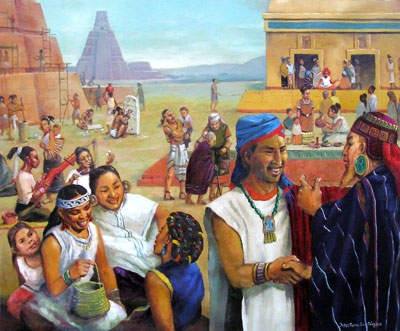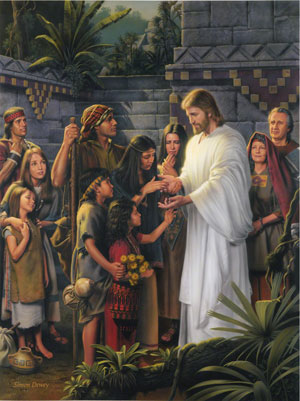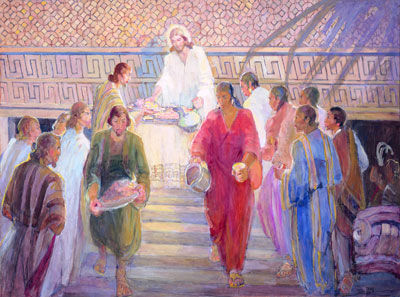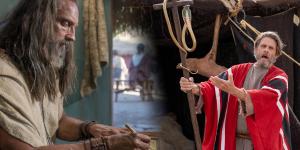You are here
Why Did the Peace Last So Long in 4 Nephi?

4 Nephi 1:16
The Know
The historical era recorded in 4 Nephi has been described as the “most glorious, happy, progressive, and enlightened time in all the combined Jaredite, Nephite, and Lamanite civilizations.”1 Mormon reported, “surely there could not be a happier people among all the people who had been created by the hand of God” (4 Nephi 1:16). Andrew C. Skinner explained, “In forty-nine short verses we are shown the practical workings of the law of the celestial kingdom, the true order of heaven on earth, and the ideal pattern of welfare service.”2
Mormon’s rather sparse summary, however, may cause readers to wonder exactly how the Nephites sustained nearly two centuries of uninterrupted peace.3 While Mormon gave a brief description of the societal features which resulted from and sustained such peace,4 Robert A. Rees has suggested that this lasting stability was at least partly due to the dramatic poignancy of the events surrounding Christ’s visitation. Rees said,
Had you been a child during this momentous time, imagine what your life would be like for the remainder of your days; imagine the stories you would tell to others about that all-encompassing darkness that enshrouded you in night and how, in your moment of deepest despair, the light came, first as a voice and then as a ray that blossomed into a person as bright as the sun, and how His light flowed into your eyes and into your heart, making your whole body as luminous as sunlight.5
Such experiences would certainly have left lasting impressions and are an indication that “loving, blessing, and teaching the children must have been an integral part of [Christ’s] mission.”6 Those who were children at the time of Christ’s visitation would have grown up to be the parents and grandparents of the rising generations. Rees proposed that “these great events, these powerful personal narratives of light overpowering the darkness, would have been told and retold” among the people.7
Moreover, it seems likely that these sacred stories would have been transmitted to rising generations as faithful saints “[continued] in fasting and prayer, and in meeting together oft both to pray and to hear the word of the Lord” (4 Nephi 1:12).8
As children and grandchildren partook of the sacrament and worshiped with those who had participated in the profound events of Christ’s ministry, they too would have felt the power of Christ’s love and mercy.9 They would have heard the stories of His supernal prayers and miraculous healings.10 They would have listened to the testimonies of those who had personally seen and heard and felt the resurrected Savior.11 In this spirit of unity, they would have gained their own testimonies of the goodness of Christ.
The Why
While societies in every age have sought the key to lasting peace and happiness, few have obtained it.12 Some have turned solely to large-scale social reforms or sweeping legislative actions. Yet while such efforts sometimes accomplish much good, they tend to lack the personalized concern and transformative love that emanates from Jesus Christ and His Atonement.
Elder Dale G. Renlund has emphasized that “the greater the distance between the giver and the receiver, the more the receiver develops a sense of entitlement.”13 Notably, as each successive generation in 4 Nephi became further removed from those who had personal contact with the Savior, they also became further removed from His peace, love, and joy.14 Mormon eventually reported that the people “did dwindle in unbelief and wickedness, from year to year” (4 Nephi 1:34).15
Yet concerning those who remained righteous, Nephi the son of Lehi prophesied, “the Son of Righteousness shall appear unto them; and he shall heal them, and they shall have peace with him, until three generations shall have passed away” (2 Nephi 26:9). The phrase “have peace with him” suggests that the first three generations were in some way accompanied by Jesus. While Nephi’s statement certainly relates to spiritual unity, Mormon confirmed its literal fulfillment when reporting that after Christ’s three-day visitation, He “did show himself unto them oft, and did break bread oft, and bless it, and give it unto them” (3 Nephi 26:13).
Whereas worldly institutions tend to increasingly distance receivers from their givers, the divine institution of the sacrament is intended to remove the gap between individual receivers and their true Giver, Jesus Christ. It allowed the rising generations in 4 Nephi to feel in their hearts what their ancestors felt and, perhaps on occasion, to experience Christ’s personal visitation for themselves.
Indeed, Mormon’s only explicit explanation for how the people obtained such peace and happiness was “because of the love of God which did dwell in the hearts of the people” (4 Nephi 1:15).16 This love—which Moroni called “the pure love of Christ” (Moroni 7:47)—was surely bestowed upon faithful believers in accordance with Christ’s sacramental promise: “ye shall have my Spirit to be with you” (3 Nephi 18:11).
Thankfully, the Lord in His abundant mercy has restored the blessings of the sacrament in the latter days (see Doctrine and Covenants 20:75–79). Elder Dallin H. Oaks has taught, “The ordinance of the sacrament makes the sacrament meeting the most sacred and important meeting in the Church. It is the only Sabbath meeting the entire family can attend together.”17 This unifying ordinance allows each worthy individual and each righteous family to draw near unto Jesus, so that like the blessed generations in 4 Nephi, they too can “have peace with him”(2 Nephi 26:9, emphasis added) and be “filled with the love of God” (4 Nephi 1:15).
Further Reading
Robert A. Rees, “Children of Light: How the Nephites Sustained Two Centuries of Peace,” in Third Nephi: An Incomparable Scripture, ed. Andrew C. Skinner and Gaye Strathearn (Salt Lake City and Provo, UT: Deseret Book and Neal A. Maxwell Institute for Religious Scholarship, 2012), 309-328.
M. Gawain Wells, “The Savior and the Children in 3 Nephi,” Journal of Book of Mormon Studies 14, no. 1 (2005): 62–73, 129.
Lindon J. Robinson, “‘No Poor Among Them,’” Journal of Book of Mormon Studies 14, no. 1 (2005): 86–97, 130.
Byron R. Merrill, “There Was No Contention,” in Fourth Nephi, From Zion to Destruction, ed. Monte S. Nyman and Charles D. Tate Jr. (Provo, UT: Religious Studies Center, Brigham Young University, 1995), 167–183.
- 1. D. Kelly Ogden and Andrew C. Skinner, Verse by Verse: The Book of Mormon, 2 vols. (Salt Lake City, UT: Deseret Book, 2011), 2:228.
- 2. Andrew C. Skinner, “The Course of Peace and Apostasy: 4 Nephi–Mormon 2,” in Book of Mormon, Part 2: Alma 30 to Moroni, ed. Kent P. Jackson, Studies in Scripture: Volume 8 (Salt Lake City, UT: Deseret Book, 1988), 218.
- 3. For one possible explanation of Mormon’s lack of information in 4 Nephi, see Brant A. Gardner, “Mormon’s Editorial Method and Meta-Message,” FARMS Review 21, no. 1 (2009): 99–105.
- 4. Mormon reported that the people “had all things common among them” (4 Nephi 1:3). The disciples performed many miracles “in the name of Jesus” (v. 5). The people “did multiply exceedingly fast” and “were married, and given in marriage” (vv. 10–11). There were no “envyings, nor strifes, nor tumults, nor whoredoms, nor lyings, nor murders, nor any manner of lasciviousness …. [nor] robbers, nor murderers, neither were there Lamanites, nor any manner of -ites" (vv. 17–18). The picture evoked from this description is one of economic equality, fully active spiritual gifts, loving marriages and families, and the elimination of crime, sin, and unhealthy social distinctions. For further analysis and application of these blessed conditions, see Marlin K. Jensen, “Living after the Manner of Happiness,” Ensign, December 2002, online at lds.org; Lindon J. Robinson, “‘No Poor Among Them,’” Journal of Book of Mormon Studies 14, no. 1 (2005): 86–97, 130.
- 5. Robert A. Rees, “Children of Light: How the Nephites Sustained Two Centuries of Peace,” in Third Nephi: An Incomparable Scripture, ed. Andrew C. Skinner and Gaye Strathearn (Salt Lake City and Provo, UT: Deseret Book and Neal A. Maxwell Institute for Religious Scholarship, 2012), 320-321.
- 6. M. Gawain Wells, “The Savior and the Children in 3 Nephi,” Journal of Book of Mormon Studies 14, no. 1 (2005): 66.
- 7. Rees, “Children of Light,” 321.
- 8. That these meetings were sacramental in nature is partially evidenced by Mormon’s introductory statement that “they did not walk any more after the performances and ordinances of the law of Moses” (4 Nephi 1:12). Christ’s atoning sacrifice signaled a fulfillment of these Mosaic ordinances and ushered in a higher law accompanied by the ordinance of the sacrament. Moreover, Mormon’s use of the phrase “meeting together oft” in 4 Nephi 1:12 mirror’s Christ’s commandment to “meet together oft” which is found in the sacramental context of 3 Nephi 18:22. Clearly these meetings fulfilled Christ’s injunction to “always do these things,” which referred to the sacramental meetings and ordinances (3 Nephi 18:12).
- 9. See Richard Lloyd Anderson, “Religious Validity: The Sacrament Covenant in Third Nephi,” in By Study and Also By Faith: Studies in Honor of Hugh Nibley, 2 vols., ed. John M. Lundquist and Stephen D. Ricks (Salt Lake City and Provo, UT: Deseret Book and FARMS, 1990), 2:1-51; Book of Mormon Central, “Why Did the Savior Emphasize His Risen Body in the Nephite Sacrament? (3 Nephi 18:7),” KnoWhy 211 (October 18, 2016).
- 10. For example, those who witnessed Jesus praying for them reported that “no tongue can speak, neither can there be written by any man, neither can the hearts of men conceive so great and marvelous things as we both saw and heard Jesus speak; and no one can conceive of the joy which filled our souls at the time we heard him pray for us unto the Father” (3 Nephi 17:17).
- 11. See Book of Mormon Central, “Why Did Jesus Minister to the People One by One? (3 Nephi 17:21),” KnoWhy 209 (October 14, 2016).
- 12. See Byron R. Merrill, “There Was No Contention,” in Fourth Nephi, From Zion to Destruction, ed. Monte S. Nyman and Charles D. Tate Jr. (Provo, UT: Religious Studies Center, Brigham Young University, 1995), 169: “With periods of peace being so scarce in the narrative, having a time with no contention must have seemed to Mormon a virtually unattainable condition. Considering the circumstances of his day in combination with all the history he had reviewed, Mormon mentions the absence of contention four times in 17 verses as if to convince himself of such a wonderment, to dispel the belief that this is only a heavenly goal, and to reinforce the possibility of a contentionless people.”
- 13. Dale G. Renlund, “That I Might Draw All Men Unto Me,” Ensign, May 2016, 39, online at lds.org.
- 14. Mormon’s first indication of social decline was that a “small part of the people … had revolted from the church” (4 Nephi 1:20). Upon removing themselves from Christ’s covenants and ordinances, they began to be “lifted up in pride,” filled with greed, and “divided into classes” (vv. 24–26). After “two hundred and ten years had passed away there were many churches … which professed to know the Christ, and yet they did deny the more parts of his gospel” (v. 27).
- 15. Summarizing Hugh Nibley’s assessment of the Nephite downfall, John Welch explained that “first they became privatized. Then they became ethnicized—they taught their children to hate the Nephites or the Lamanites. Then they became nationalized, militarized, terrorized, regionalized, tribalized, fragmentized, polarized, pulverized—and eventually vaporized.” See John W. Welch, “Understanding the Sermon at the Temple: Zion Society,” in Hugh Nibley, Teachings of the Book of Mormon, 4 vols. (American Fork and Provo, UT: Covenant Communications and FARMS, 2004), 4:172. For Hugh Nibley’s original and more expansive treatment of this topic, see Hugh Nibley, The Prophetic Book of Mormon, The Collected Works of Hugh Nibley, Volume 8 (Salt Lake City and Provo, UT: Deseret Book and FARMS, 1992), 530–531.
- 16. See John H. Groberg, “The Power of God’s Love,” Ensign, November 2004, online at lds.org: “When filled with God’s love, we can do and see and understand things that we could not otherwise do or see or understand. Filled with His love, we can … avoid contention, renew strength, and bless and help others in ways surprising even to us.”
- 17. Dallin H. Oaks, “Sacrament Meeting and the Sacrament,” Ensign, November 2008, 17, online at lds.org.
KnoWhy Citation
Related KnoWhys
Subscribe
Get the latest updates on Book of Mormon topics and research for free








